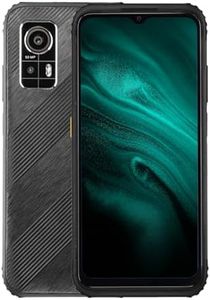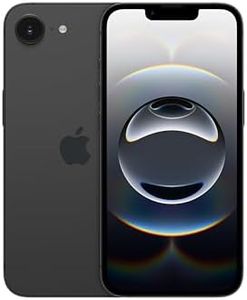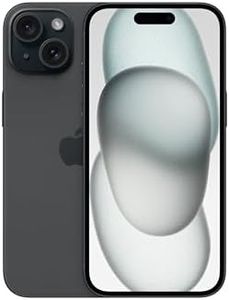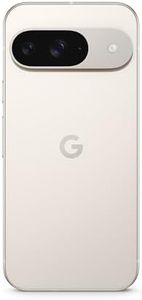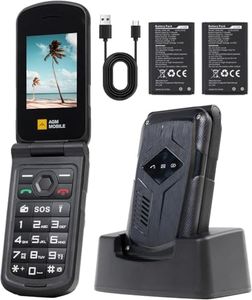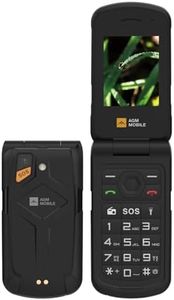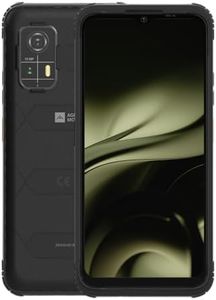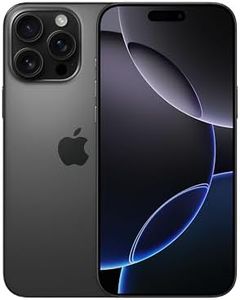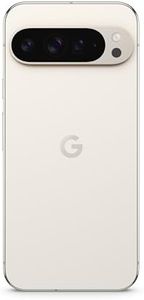10 Beste Smartphones
Von führenden Marken und Bestsellern, die im Internet erhältlich sind.Unsere Top-Auswahl
Gewinner
iPhone 16e 128 GB: Entwickelt für Apple Intelligence, A18 Chip, Gigantische Batterielaufzeit, 48 MP Fusion Kamera, 6,1" Super Retina XDR Display, Schwarz
Das Apple iPhone 16e ist ein solides Smartphone, das besonders durch sein 6,1 Zoll großes Super Retina XDR OLED-Display überzeugt. Die Bildqualität ist sehr scharf und farbkräftig, ideal für Medienkonsum oder Alltagseinsatz. Angetrieben wird das Gerät vom leistungsstarken A18 Chip, der schnelle Reaktionen garantiert und auch bei Spielen oder anspruchsvollen Apps flüssig arbeitet. Mit 128 GB Speicher bietet es ausreichend Platz für Fotos, Apps und Dateien, wobei der Speicher nicht erweiterbar ist. Die 48 MP Fusion Hauptkamera liefert hochauflösende Fotos und besitzt einen 2-fachen optischen Zoom, was für gute Detailaufnahmen sorgt. Die 12 MP Frontkamera ist für Selfies und Videoanrufe gut geeignet.
Ein großes Plus ist die lange Akkulaufzeit mit bis zu 26 Stunden Videowiedergabe, was den Nutzer im Alltag entlastet. Das iPhone 16e läuft mit iOS 18, das viele Anpassungsmöglichkeiten und regelmäßige Updates bietet. Das robuste Design mit Ceramic Shield ist widerstandsfähig gegen Kratzer und Stürze, was das Gerät langlebiger macht. Weitere praktische Features sind die Dual-SIM-Unterstützung, der schnelle USB-C Anschluss sowie ein neuer Action-Button für schnelle Zugriffe. Ein kleiner Nachteil könnte sein, dass der Speicher mit 128 GB für manche Nutzer schnell knapp werden kann, besonders ohne Speichererweiterung. Auch ist der Preis oft höher als bei vergleichbaren Android-Modellen. Das iPhone 16e eignet sich besonders für Anwender, die Wert auf ein hochwertiges Display, starke Leistung, lange Akkulaufzeit und ein sicheres Betriebssystem legen.
Apple iPhone 16 128 GB: 5G Handy mit Kamerasteuerung, A18 Chip und einem echten Boost für die Batterie. Funktioniert mit AirPods, Schwarz
Das Apple iPhone 16 mit 128 GB Speicher ist ein solides Smartphone, das vor allem Nutzer anspricht, die Wert auf eine gute Kamera und eine starke Leistung legen. Das Display bietet mit einer Auflösung von 2556x1179 scharfe Bilder, allerdings mit einer Standard-Aktualisierungsrate von 60 Hz, was für flüssiges Scrollen ausreicht, aber nicht so geschmeidig ist wie bei manchen Konkurrenzgeräten mit höheren Bildraten. Angetrieben wird das Gerät vom sehr leistungsfähigen A18 Chip, der nicht nur schnelle Abläufe ermöglicht, sondern auch energieeffizient arbeitet und somit die Batterielaufzeit auf bis zu 22 Stunden Videowiedergabe verlängert. Die 8 GB RAM sorgen für flüssiges Multitasking, und mit 128 GB Speicher bietet das iPhone genug Platz für Fotos, Apps und Medien – für manche Nutzer könnte das jedoch etwas knapp sein, wenn viele große Dateien gespeichert werden sollen.
Die Kamera überzeugt mit einer 48 MP Fusion-Hauptkamera, einer verbesserten Ultraweitwinkel-Kamera mit Autofokus sowie 2-fachem optischem Zoom, was sowohl makro- als auch detailreiche Fotos ermöglicht. Die neue Kamerasteuerung und die fotografischen Stile bieten kreative Möglichkeiten, die besonders Fotofans gefallen dürften. Das Betriebssystem iOS ist bekannt für seine Nutzerfreundlichkeit, regelmäßige Updates und gute Integration mit anderen Apple Produkten wie AirPods. Der USB-C-Anschluss ist ein willkommenes Update für schnelles und universelles Laden. Das Design bleibt hochwertig und die Verarbeitung solide, typisch für Apple. Ein möglicher Nachteil ist die fehlende 120 Hz Bildwiederholrate, die in dieser Preisklasse inzwischen öfter zu finden ist, sowie der moderate Speicherplatz ohne Erweiterungsmöglichkeiten. Nutzer, die ein leistungsstarkes, gut ausgestattetes Smartphone mit Fokus auf Kameraqualität und langer Akkulaufzeit suchen, finden hier ein gutes Angebot, besonders wenn sie bereits im Apple-Ökosystem unterwegs sind.
Apple iPhone 16 Pro 256 GB: 5G Handy mit Kamerasteuerung, 4K 120 fps Dolby Vision und einem großen Sprung bei der Batterielaufzeit. Funktioniert mit AirPods, Titan Wüstensand
Das Apple iPhone 16 Pro bietet ein großes und beeindruckendes 6,3 Zoll Super Retina XDR Display, das durch das extrem harte Ceramic Shield gut vor Kratzern und Stößen geschützt ist. Das gesamte Gehäuse besteht aus leichtem Titan, was das Handy robust und gleichzeitig angenehm zu halten macht. Im Inneren sorgt ein leistungsstarker Prozessor für flüssige Bedienung und schnelle Reaktionen, unterstützt von ausreichend RAM, um auch viele Apps gleichzeitig laufen zu lassen. Mit 256 GB Speicherplatz gibt es viel Platz für Fotos, Videos und Apps.
Besonders stark zeigt sich das iPhone 16 Pro bei der Kamera: Die 48 MP Ultraweitwinkel- und 5x Tele-Kamera ermöglichen detailreiche Aufnahmen nah und fern, ideal für Hobbyfotografen. Videos können in professioneller 4K-Qualität mit hoher Bildrate und Dolby Vision aufgenommen werden, was für besonders hochwertige Ergebnisse sorgt. Die neue Kamerasteuerung macht das Fotografieren einfacher und flexibler. Die Batterielaufzeit wurde spürbar verbessert, sodass das Gerät länger durchhält, was ein großer Pluspunkt ist.
Das Betriebssystem bietet eine benutzerfreundliche Oberfläche und regelmäßige Updates, die Sicherheit und neue Funktionen gewährleisten. Ein kleiner Nachteil könnte der relativ hohe Preis sein, typisch für Apple-Geräte, und wer mehr Speicher braucht, muss eventuell zu einer größeren Variante greifen. Das iPhone 16 Pro eignet sich besonders für Nutzer, die Wert auf Design, Kameraqualität und eine lange Akkulaufzeit legen und bereit sind, in ein Premium-Smartphone zu investieren.
Top-Auswahl vergleichen
iPhone 16e 128 GB: Entwickelt für Apple Intelligence, A18 Chip, Gigantische Batterielaufzeit, 48 MP Fusion Kamera, 6,1" Super Retina XDR Display, Schwarz Auf Amazon ansehen | Apple iPhone 16 128 GB: 5G Handy mit Kamerasteuerung, A18 Chip und einem echten Boost für die Batterie. Funktioniert mit AirPods, Schwarz Auf Amazon ansehen | Apple iPhone 16 Pro 256 GB: 5G Handy mit Kamerasteuerung, 4K 120 fps Dolby Vision und einem großen Sprung bei der Batterielaufzeit. Funktioniert mit AirPods, Titan Wüstensand Auf Amazon ansehen |
|---|---|---|
| Angebot | ||
17%billiger | 8%billiger | - |
| Ausgewählt von | ||
| 1.432 | 1.330 | 1.228 |
| Mehrere Stile verfügbar | ||
| Display Size and Quality | ||
| 6,1 Zoll Super Retina XDR OLED | 2556x1179, 60 Hz | 6,3 Zoll Super Retina XDR |
| Processor (CPU) | ||
| A18 Chip | A18 Chip | leistungsstarker Prozessor |
| Storage Capacity | ||
| 128 GB | 128 GB | 256 GB |
| Camera Quality | ||
| 48 MP Hauptkamera, 12 MP Front | 48 MP Hauptkamera, Ultraweitwinkel, Zoom | 48 MP Ultraweitwinkel, 5x Tele-Kamera |
| Battery Life | ||
| Bis zu 26 Stunden Video | bis zu 22 Stunden Video | spürbar verbessert |
| Operating System and Updates | ||
| iOS 18 | iOS mit regelmäßigen Updates | benutzerfreundlich, regelmäßige Updates |
| Build Quality and Design | ||
| Robustes Design mit Ceramic Shield | hochwertig, solide Verarbeitung | Titan-Gehäuse, Ceramic Shield |
| RAM | ||
| -- | 8 GB | ausreichend RAM |
